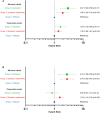Phenotyping of Elderly Patients With Heart Failure Focused on Noncardiac Conditions: A Latent Class Analysis From a Multicenter Registry of Patients Hospitalized With Heart Failure
- PMID: 36695300
- PMCID: PMC9973643
- DOI: 10.1161/JAHA.122.027689
Phenotyping of Elderly Patients With Heart Failure Focused on Noncardiac Conditions: A Latent Class Analysis From a Multicenter Registry of Patients Hospitalized With Heart Failure
Abstract
Background The burden of noncardiovascular conditions is becoming increasingly prevalent in patients with heart failure (HF). We aimed to identify novel phenogroups incorporating noncardiovascular conditions to facilitate understanding and risk stratification in elderly patients with HF. Methods and Results Data from a total of 1881 (61.2%) patients aged ≥65 years were extracted from a prospective multicenter registry of patients hospitalized for acute HF (N=3072). We constructed subgroups of patients with HF with preserved ejection fraction (HFpEF; N=826, 43.9%) and those with non-HFpEF (N=1055, 56.1%). Latent class analysis was performed in each subgroup using 17 variables focused on noncardiovascular conditions (including comorbidities, Clinical Frailty Scale, and Geriatric Nutritional Risk Index). The latent class analysis revealed 3 distinct clinical phenogroups in both HFpEF and non-HFpEF subgroups: (1) robust physical and nutritional status (Group 1: HFpEF, 41.2%; non-HFpEF, 46.0%); (2) multimorbid patients with renal impairment (Group 2: HFpEF, 40.8%; non-HFpEF, 41.9%); and (3) malnourished patients (Group 3: HFpEF, 18.0%; non-HFpEF, 12.1%). After multivariable adjustment, compared with Group 1, patients in Groups 2 and 3 had a higher risk for all-cause death over the 1-year postdischarge period (hazard ratio [HR], 2.79 [95% CI, 1.64-4.81] and HR, 2.73 [95% CI, 1.39-5.35] in HFpEF; HR, 1.96 [95% CI, 1.22-3.14] and HR, 2.97 [95% CI, 1.64-5.38] in non-HFpEF; respectively). Conclusions In elderly patients with HF, the phenomapping focused on incorporating noncardiovascular conditions identified 3 phenogroups, each representing distinct clinical outcomes, and the discrimination pattern was similar for both patients with HFpEF and non-HFpEF. This classification provides novel risk stratification and may aid in clinical decision making.
Keywords: elderly patients; heart failure; noncardiovascular conditions; phenotyping.
Figures






References
-
- Virani SS, Alonso A, Aparicio HJ, Benjamin EJ, Bittencourt MS, Callaway CW, Carson AP, Chamberlain AM, Cheng S, Delling FN, et al. Heart disease and stroke statistics‐2021 update: a report from the American Heart Association. Circulation. 2021;143:e254–e743. doi: 10.1161/CIR.0000000000000950 - DOI - PubMed
-
- Abbafati C, Abbas KM, Abbasi‐Kangevari M, Abd‐Allah F, Abdelalim A, Abdollahi M, Abdollahpour I, Abegaz KH, Abolhassani H, Aboyans V, et al. Global burden of 369 diseases and injuries in 204 countries and territories, 1990–2019: a systematic analysis for the global burden of disease study 2019. Lancet. 2020;396:1204–1222. doi: 10.1016/S0140-6736(20)30925-9 - DOI - PMC - PubMed
-
- Ueda T, Kawakami R, Horii M, Sugawara Y, Matsumoto T, Okada S, Nishida T, Soeda T, Okayama S, Somekawa S, et al. Noncardiovascular death, especially infection, is a significant cause of death in elderly patients with acutely decompensated heart failure. J Card Fail. 2014;20:174–180. doi: 10.1016/j.cardfail.2013.12.007 - DOI - PubMed
-
- Tromp J, Shen L, Jhund PS, Anand IS, Carson PE, Desai AS, Granger CB, Komajda M, McKelvie RS, Pfeffer MA, et al. Age‐related characteristics and outcomes of patients with heart failure with preserved ejection fraction. J Am Coll Cardiol. 2019;74:601–612. doi: 10.1016/j.jacc.2019.05.052 - DOI - PubMed
Publication types
MeSH terms
LinkOut - more resources
Full Text Sources
Medical
Research Materials
Miscellaneous

